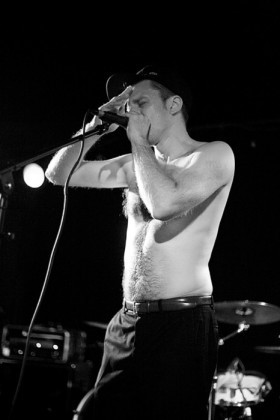The Shivers Face Their Big Moment
The Shivers Face Their Big Moment
by John Cantwell

Keith Zarriello, lead singer/songwriter/guitarist for the Shivers, climbs on stage wearing a Scream mask. He begins sing-rapping through the mask’s distorted mouth hole, informing someone, perhaps the packed crowd at the Mercury Lounge, but just as likely some distant unrequited lover, that they’re going to want and subsequently need his love. Between half-verses he does a weird little dance, his arms and legs pumping up and down, and then, without warning, he’s brandishing a two-inch pocket knife. It’s not an exceptionally intimidating blade, basically on the order of the metal files sometimes built into toenail clippers, but Keith starts stabbing at his neck with the thing, and then a rush of very fake blood pours from his throat. Keith’s all-black outfit — black jacket, black t-shirt, black jeans, black shoes — obscures any potential gore effect. Mostly, as the liquid absorbs into his shirt, it just seems as though Keith’s suddenly become very sweaty. Jo Schornikow, the Shivers’ keyboardist and backup singer, and Keith’s only bandmate, has been steadily tapping a bass line on the keys this whole time.
Then in one move, Keith rips off the mask and the neck brace to which the blood packet had been taped, picks up a black-on-black Fender and launches into the first lyrics of “Kisses.” The song, one of the best from the Shivers’ new record, More, starts with pleading (“Give me your kisses, baby, I’m just a rock and roll kid”) before growing increasingly bold and ultimately defiant. On More the song is played with sweetness and melancholy and slow-roiling urgency, but now the band dirties it up, with Keith barking out the lyrics, laying bare soul underpinnings that only sometimes surface on the band’s records. By time Jo begins a stomping, gospel-y organ solo, the crowd’s been worked into a happy, sweaty knot.
The occasion for this strange and wonderful display is the Shivers’ record release party, held at the end of May. More is the first Shivers record released on a label. Everything the band’s done previously — five records since 2004 — has been recorded, produced, funded and distributed by the Shivers themselves. In that time the band has amassed a small, but devoted following (to which I belong), but little in the way of critical notice or material success. By any measure, this should be the Shivers’ coming-out moment, a chance for the band to make a long-overdue move to the Next Level. Whether or not this happens, however, will depend on many things.
***

The day before the release party, I take the G out to Long Island City to meet Keith and Jo. The plan is to head to Flushing, where the Shivers rehearse, do some interviews, grab a bite and call it a day. Keith meets me at the stop by himself. He’s on the phone. “I texted him last night and said rehearsal was at one. He said he didn’t get my message. So now he won’t be here until five. I can show you the message.” Keith hangs up and explains: Andy Tobiassen, formerly of the band Deer Tick and now a member of Trashgut, is coming down from Providence to play drums in the show. But there was a mix-up with the message and Jo was already out in Flushing and Andy wouldn’t be here until later and, in short, the plan is temporarily fucked. We decide to walk back to Keith’s place and wait for Jo.
Keith seems nervous. But then, in the few times I’d met him before, Keith’s always seemed nervous. He looks down at his shoes a lot, shifts his weight back and forth, doesn’t do well with compliments. He confesses, frequently, that he attracts precisely zero groupies at shows. He gives the impression of being internally spring-loaded, all potential energy. I also sense that right now he’s feeling me out.
The Shivers just got back from a small West Coast tour. In an earlier conversation with me, Keith had mentioned a rocky show in Salt Lake City. When I ask about the show now he starts telling me how he visited the Salt Lake Temple and that these two girls came up to him and started telling him all about Joseph Smith, and then they showed him this huge mural. I ask if the band’s going on tour after the release party. Keith asks why I’m asking, and the subject is changed.
The apartment is a little third-floor railroad on a sleepy block in Long Island City, near the Astoria border. There’s a design studio next door that only sells white chairs and white couches. Keith sleeps in the living room on an uncomfortable-looking sofa. He tells me this is actually Jo’s apartment, and that he’s moving out tonight, subletting a friend’s place for a month. He needs the space and the quiet so he can write the second draft of his novel. The novel is about morals. I note a large suitcase with Keith’s name and phone number written on the tag, but no address.
Keith is 31 years old. He left home when he was 16 and hasn’t been back since. He has a day job as a realtor renting apartments on commission. Until recently he worked at a Domino’s Pizza in Queens. He takes long walks and thinks about songs. He writes stuff almost no one writes well anymore: dense, intelligent three- and four-minute rock songs that feel vital and necessary. He is, no bullshit, one of the best songwriters working today.
Jo, who arrives a few minutes after Keith and me, is in many ways Keith’s opposite. She’s tall and graceful, with long arms and legs. She laughs easily. A huge, floppy-brim hat sits atop her head; it’s precaution against sunburn, a concern of hers.

A native of Melbourne, Australia, Jo discovered the Shivers in 2006 while recovering from a broken back sustained in a fall. Bedridden, she passed the time listening to three records: Ella Fitzgerald Sings the Cole Porter Songbook, Nico’s Chelsea Girl and Charades by the Shivers. Charades was her favorite. After she got well, Jo reached out to Keith and they began a regular correspondence. They met in New York and wound up in front of a piano at a church in the Bronx. (The Shivers always seem to wind up in churches.) Jo played for Keith a reworked version of “L.I.E.” from Charades. Keith’s assessment was: “Whoa.“ Keith flew to Australia to visit. In 2007, Jo left Melbourne, along with a career as a successful jazz pianist, and moved to Queens. By this point she and Keith were dating. They’ve since broken up.
When Jo joined the band, Keith had already released two records under the Shivers name, Charades and Phone Calls. These were more or less solo records made with a rotating cast of musicians. Both are deliberately lo-fi, at points brilliant, but burdened with excess tracks. The Shivers records made with Jo — Beaks to the Moon, In the Morning, Sunset Psalms and More — are tighter, warmer, more approachable. Alex Saltz, a mastering engineer and longtime friend of the band, says Jo brought “a whole other level of musical sophistication and unity” to the band. At the same time, she pushed Keith, who has no formal training, to become a better player.
Here in the apartment, however, Keith and Jo don’t seem too unified. They’re bickering over the day’s plans. Jo’s hoping to squeeze in some yoga. Keith suggests they head to Flushing and rehearse now. “Why did I just come back here then?” Jo asks. I sense that this isn’t the first time such an argument has occurred.
***
Examples of Keith’s stage banter at the release party: “Rock and roll is all about throwing up.” “This next song’s about when you’re trying to get with some girl and can’t go to the bathroom.” “I suffer from irritable bowel syndrome.”
The night’s second song is “Love is in the Air.” Sung from the perspective of someone about to be dumped, the opening lyrics invert Paul’s Letter to the Corinthians: “Love doesn’t know, that there’s a pretty good chance you’re going to go/Love doesn’t see, that you’re not still in love with me.” The Shivers play it as a sing-along breakup jam.
“Love is in the Air” features several of Keith’s songwriting trademarks: immediate intimacy and tension; a preoccupation with vulnerability and emotional nakedness; a streak of wounded defiance. Moreover, the song deals with idealized romantic love, a subject that borders on obsession for Keith. Short of Bieber, nobody sings about love as frequently or directly.
Keith’s mono-fixation has yielded some truly devastating stuff. There are breakup songs so sad you think you very well might barf: “He Who Made You,” “Warm in the Morning,” “So Long Woman.” Then you have the ache-inducing songs of longing: “Love you Like a Dog,” “More.” The rarest and most thrilling are the ones in which the hurt and pining melt away, allowing something like catharsis to shine through with a warm honey glow. Two such songs, “Beauty” and “L.I.E.,” are among the most stunning you’ll ever hear.
Jonathan Lethem wrote that James Brown was “forever chasing something, a pure hard-flat-jazz-funk he heard once in his dreams, and toward which all subsequent efforts have been pointed.” A similar sentiment may be true for Keith re: love songs. He not only circles the subject again and again, he also revisits particular songs. A number of tracks on More have surfaced on other records: “Love is in the Air” and “Used to Be” also appear on Keith’s pseudo-concept solo record Truants from Life; a grittier version of “Kisses” can be found on Charades. In other instances, songs reappear under different titles. There are a few motivations for the constant reworking. One is the involvement of Jo: many of the revised tracks were originally made in Jo-less sessions, and each time her presence is introduced the song gains a new vitality. Then there’s the fact that Keith never seems to leave things alone.
***
Jo’s off at yoga. Keith and I just ordered burgers. I ask about the band’s goals.
That’s when Keith tells me the Shivers are breaking up. He wants to write his book and he wants to rap. He’s taking time off, selling his amp and his car. Tomorrow’s their last show.
Well, then.
***

The Shivers rehearse at Flushing Messiah Lutheran Church in Queens. Jo is the church’s organist, a gig that requires her to play just one mass and one choir practice a week. In exchange she earns enough to cover rent, and the band’s allowed to rehearse whenever they want (except during Mass of course) and store their gear for free. It’s a smallish church, built to hold a few hundred people, with hardwood floors and a crimson carpet running down the center aisle. The band sets up in front of the altar, and orients itself toward the empty pews.
The first song they rehearse is “Dance,” a great, as-yet-unrecorded track written by Jo. It’s about bodily disassociation — feeling yourself being watched, and watching the watcher, and then feeling the watcher watching you watch them — and will be the third song in tomorrow night’s set. “Dance” receives more attention than any other song. This is mostly for the benefit of Andy, the drummer, who has to learn it on the fly.
“Dance” is driven forward by the bass line, played by Jo, and requires Andy to gradually add new layers as it progresses. “It’s simple,” Jo tells Andy as she keys the first notes. Andy tries to ride along, but Jo keeps on stopping him, telling him to do less, to let things build gradually. There is nothing simple about the song.
Alex Saltz, the Shivers’ mastering engineer, also played drums with the band for a while. He told me rehearsals could be a grind. “Keith and Jo are meticulous arrangers,” he said. “They’d get super specific with their feedback. Like, ‘Play the high hat one time less there.’” Alex also said he learned a lot from the band. “They taught me about musical economy.”
This rehearsal was grueling at times. When the band first started running through “Dance,” Keith told Jo she should sing through the mic. She said she doesn’t want to, but Keith carried the microphone stand over to her nevertheless, placing the mic half an inch from her face. He did the same thing when they came back to “Dance” later. Yet, as grueling as it was, rehearsal was also the first time that day that I noted some kind of flow or easiness in the group. Keith and Jo settled into pleasant banter with Andy as they set up their gear, talking about mutual friends they’d seen on the West Coast tour. When the band played through “Kisses,” Jo suggested a slight adjustment that would better frame the song’s final lyrics. “That’s a great line,” she said to Keith. Later, they ripped through an extended jam of “Shallow Water,” one the Shivers’ few legitimately hard-rockers. By the end, it was all smiles.
Keith and Jo have a connection when they play. Each mentioned it to me separately over the course of the day, though it’s not the kind of thing that needs mentioning. It’s palpable to anyone watching them. Jo enters something like a frenzy: hips swaying, right foot stomping the ground in time, hair falling all over her face. Whenever he’s not singing, Keith backs away from the mic and turns toward Jo. He stares at her, calm and level.
When rehearsal ends, we find ourselves, thanks to a slippery doorstop and some misplaced keys, temporarily locked out of the church. Andy has to lower wiry Keith through an open stained glass window. Keith opens the church from the inside, and then everyone gets back to the business of loading the cars with the gear for tomorrow’s show. As Keith closes the trunk on the amps, guitars, keyboards, stands, etc., he points to a for-sale sign in the car’s rear window, written in the same jagged hand as his luggage tag.
“Wanna buy a car?” he asks.
***

“I got a dirty dick from fuckin all these dirty bitches.”
And with these words, the Mercury Lounge is introduced to Sad Eyes Zarriello, Keith’s rap alter ego.
Sad Eyes dons a fitted Yankee cap, pulled down low. He gives shout-outs to the Palisades Mall in Nyack, New York (Keith’s originally from Rockland County, though his accent is all Queens), Subway, Domino’s Pizza and Oxycontin. Sad Eyes does not wear a shirt.
Like many rappers, Sad Eyes is a misogynist. (I heard “cum zombie in the back of an Abercombie” somewhere in there.) Keith told me at lunch that this was a deliberate pose intended to bring attention to misogyny, which Keith hates. Keith sees his raps as ideological companions to his love songs. The difference, he thinks, is that the raps can be more profitable. He’s not entirely off base. Keith can rap and his gravelly voice is ideally suited for being an MC.
The fact that Keith would do a 180 from love songs to rap is in keeping with his character. When he was 23, for instance, Keith started the American chapter of the Anti-Sexual/Anti-Childbirth movement. He produced literature, gave speeches, distributed pamphlets in front of the Museum of Sex in Manhattan. When I asked why he of all people did this, he said, “A girl broke my heart.”
Keith introduced Sad Eyes just after the band had ripped through “Shallow Water.” He started by telling the crowd that this was the last night the Shivers were playing together. The statement received a chuckle because, you know, who breaks up the band right after a record release party?
***
Earlier in the day, on the way to rehearsal, Keith had to run an errand and it was just Jo and me in the car, the first time we’d been alone since Keith told me about the breakup. I asked if this was for real.
“I don’t know,” she said, and her eyes filled with water. “Keith goes in circles, and it’s really frustrating. I gave up everything to play these songs. They’re still my favorites.”
***
The Shivers close with “L.I.E.,” the song Jo played for Keith when they first met. It begins with the narrator standing outside a girl’s house, confessing he’ll never grasp even the most elemental details of her life: her mother’s laugh, a wall of family photos. As the song progresses, the narrator only gets further away, his observations becoming more and more remote. It ends with an inevitable, delirious confession of undying devotion. “L.I.E.” is a song about the simplest, easiest love there is, the kind that exists only in your head.
After the show, Jo merrily works the merch stand, selling More vinyls and Shivers t-shirts. Keith is surrounded by four girls at the bar telling him how AMAZE-ING the set was. The Shivers are scheduled to play Glasslands in Brooklyn on June 29th. The show has not been cancelled.
John Cantwell lives in Brooklyn and teaches writing in the Design Criticism program at the School of Visual Arts. He blogs sporadically.
Top photo by Scott Rudd. The other photos, taken at the Mercury Lounge, are by Angelina Santana and used with permission.
